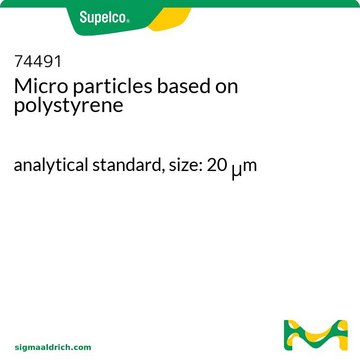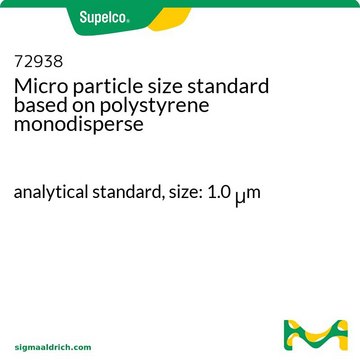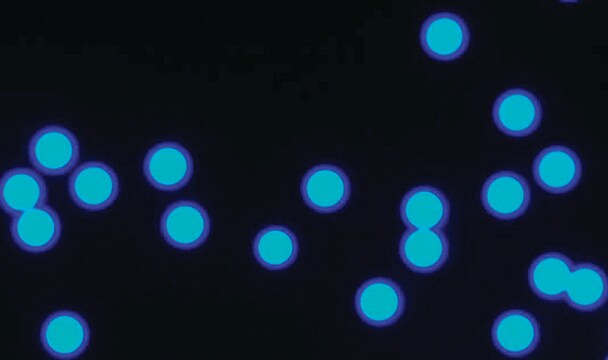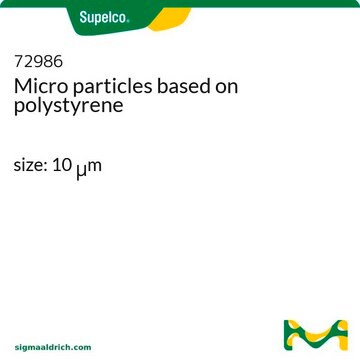95531
Micro particle size standard based on polystyrene monodisperse
analytical standard, size: 30.0 μm
동의어(들):
Monodisperse polystyrene latex particles (30 μm), monodisperse polystyrene microbeads (30 μm), monodisperse polystyrene microspheres (30 μm), polystyrene monodisperse microparticles (30 μm), Size standards
로그인조직 및 계약 가격 보기
모든 사진(1)
About This Item
추천 제품
Grade
analytical standard
Quality Level
양식
aqueous suspension
particles
교차
2 % cross-linked
농도
2% (solids)
입자 크기
30.0 μm std dev <0.5 μm, coeff var <2%
응용 분야
glass & ceramic
industrial qc
pharmaceutical
형식
neat
저장 온도
2-8°C
유사한 제품을 찾으십니까? 방문 제품 비교 안내
일반 설명
Monodisperse polystyrene based micro particles (size: 30 μm) are a particle size standard, ideal for characterizing particle size distribution (PSD) of test samples.
애플리케이션
Used to calibrate and validate the performance of particle size analyzers.
Monodisperse polystyrene latex particles can also be used to:
Monodisperse polystyrene latex particles can also be used to:
- validate the Airy Disc First Fringe (ADFF) analysis technique based on size measurements
- study the size effect of polystyrene microplastics on the sorption of organic contaminants
특징 및 장점
- suitable for routine instrument calibration checks, testing and corrections
- available in 5 mL pack size as a neat sample
분석 메모
For every lot exact values of particle size and standard deviation are determined with an accuracy of 0.001 μm. The size determination of these particles follows procedures described by National Institute of Standards and Technology (NIST, USA) respectively by the Community Bureau of Reference (BCR), esp.:
- Transmission electron microscopy (TEM)
- Scanning electron microscope
- Light microscopy
- Coulter™ counter with MDF-system
법적 정보
Coulter is a trademark of Beckman Coulter, Inc.
Storage Class Code
10 - Combustible liquids
WGK
WGK 3
Flash Point (°F)
410.0 °F
Flash Point (°C)
210 °C
개인 보호 장비
Eyeshields, Gloves
이미 열람한 고객
Shimpei Ishiyama et al.
Current biology : CB, 29(19), 3153-3164 (2019-10-01)
The relationship between tickling, sensation, and laughter is complex. Tickling or its mere anticipation makes us laugh, but not when we self-tickle. We previously showed rat somatosensory cortex drives tickling-evoked vocalizations and now investigated self-tickle suppression and tickle anticipation. We
Antoine D Madar et al.
Scientific reports, 9(1), 5282-5282 (2019-03-29)
Pattern separation is a process that minimizes overlap between patterns of neuronal activity representing similar experiences. Theoretical work suggests that the dentate gyrus (DG) performs this role for memory processing but a direct demonstration is lacking. One limitation is the
Taketoshi Sugimura et al.
Neuroscience research, 120, 36-44 (2017-03-13)
Manipulation of visual experience can considerably modify visual responses of visual cortical neurons even in adulthood in the mouse, although the modification is less profound than that observed during the critical period. Our previous studies demonstrated that low-frequency (2Hz) stimulation
Paulina M Getsy et al.
Respiratory physiology & neurobiology, 269, 103250-103250 (2019-07-29)
Acute Lung Injury (ALI) alters pulmonary reflex responses, in part due to changes in modulation within the lung and airway neuronal control networks. We hypothesized that synaptic efficacy of nucleus tractus solitarii (nTS) neurons, receiving input from lung, airway, and
Sarah H Hayes et al.
Progress in neurobiology, 196, 101893-101893 (2020-08-14)
Various theories and their associated mechanisms have been proposed as the neural basis of phantom sound perception (tinnitus), including central gain enhancement and altered cortical oscillations. However, it remains unknown whether these cortical changes directly cause tinnitus, or simply coexist
자사의 과학자팀은 생명 과학, 재료 과학, 화학 합성, 크로마토그래피, 분석 및 기타 많은 영역을 포함한 모든 과학 분야에 경험이 있습니다..
고객지원팀으로 연락바랍니다.











